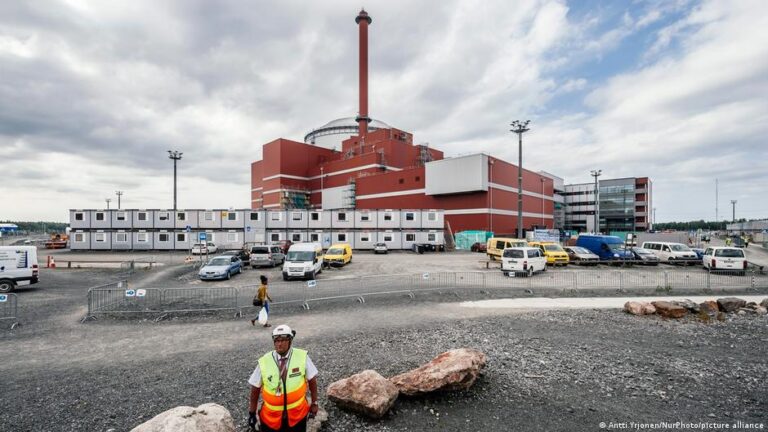Olkiluoto island on the western coast of Finland used to be just an energy hub for the country bordering Russia. But with the start of Russia’s full-scale invasion of Ukraine in February 2022, it became strategically important as Helsinki decided it could no longer rely on Russian energy.
Up until then, the country had been receiving half of its energy imports from the neighboring country, with which it shares a 1,300-kilometer (807-mile) border. They included electricity, oil and natural gas deliveries.
“Before 2022, there had been the optimistic hope we had gotten past an era where it’s all about enlarging territory and invading sovereign countries and we could live happily in peace having trade,” says Sari Multala, Finland’s minister of climate and the environment.
“But then, we understood that was not the case and that we had to take care of our own sovereignty, also when it comes to energy. We cannot depend on a hostile partner,” she told DW.
Helsinki dropped its formerly neutral stance and announced it would join the Western defense alliance NATO. Moscow cut off electricity supplies to Finland, supposedly because Helsinki refused to pay for them in the Russian currency, the ruble.
Russia’s share in Finland’s energy import has since gone down to almost zero.
Oil, which made up for 19% of Finland’s energy consumption in 2019, is now being imported from Norway, the UK and the US. Natural gas, at the time representing 5% in the country’s energy mix, is imported in its liquefied LNG form.
Finland’s state-owned company Gasgrid Finland, meanwhile, has commissioned a new floating LNG terminal in the southern port of Inga.
Nuclear energy and renewables are key
Finland’s new nuclear reactor, Olkiluoto 3 is one of the biggest in the world with a total capacity of 1,600 mega-watts (MW), and has boosted Finland’s nuclear share in electricity production from 28% in 2022 to 39% now.
But that came at a cost. Olkiluoto 3’s price tag almost quadrupled to €11 billion ($12.7 billion). Building it took 18 years instead of four as initially planned. The skyrocketing costs had operator TVO cancel plans for a fourth reactor on Olkiluoto island.
“Consumers are benefiting from low electricity prices. And we have created 5,000 direct and indirect jobs,” he told DW during a recent press tour of the reactor’s premises.
But other electricity sources also contributed to Finland’s energy shift, particularly renewables.
In 2024, onshore wind farms made up 24% of the country’s electricity production, compared with 14% in 2022.
For Veli-Pekka Tynkkynen, professor at the Finnish Centre for Russian and Eastern European Studies at the University of Helsinki, renewables are the way to go because nuclear, biomass, hydropower and wind energy would make the Finnish model “resilient.”
“But it’s very expensive to build new nuclear power plants nowadays because of the high safety standards. And we should move away from fossil energy. It’s not a good idea to be dependent on autocratic countries — be it Russia, Saudi Arabia or the US,” he told DW.
Tynkkynen added, however, that Finland had not managed to achieve complete energy independence from Russia. “Finnish energy company Fortum has tried for the past three years to substitute Russian uranium deliveries, but has not yet been able to do so,” he said.
Other European countries have also made a shift
Thijs van de Graf, associate professor for international politics at Ghent University in Belgium and an expert on energy policy, agrees that the right mix is key.
“Most European countries have looked towards other energy sources after the start of Russia’s full-scale invasion of Ukraine,” he told DW. “The recipe for energy security includes energy efficiency, electrification and renewables.”
He added this was particularly the case in countries where there was not as much political appetite for nuclear as in Finland.
According to a May 2025 poll by UK polling institute Verian, 68% of Finns have a positive opinion of nuclear energy, which is why operator TVO wouldn’t rule out building additional nuclear reactors.
Pasi Tuohimaa is communications manager at Posiva, a company owned by TVO and Fortum and specializing in the final disposal of spent nuclear fuel in the Onkalo storage facility located at the power plant site .
Posiva plays a crucial role in ensuring the safety of nuclear waste management in Finland.
On a recent afternoon, Tuohimaa was leading a group of journalists through the Onkalo project which is to open in the coming months.
The waste of the country’s five existing nuclear power plants will be stored there for good in one-ton capsules that are to be stored in chambers in the ground.
Operator Posiva has so far spent between €500 million ($577 million) and €1 billion on the storage facility encompassing 60 kilometers (37.2 miles) of tunnels about 450 meters (1,476 feet) below ground level.
“We have a solution to take care safely of the spent nuclear fuel. Excavating tunnels is not that difficult. Finland is full of bedrock. So there can be other places here and abroad,” Tuohima told DW.
Finland’s Climate and Environment Minister Sari Multala says the Nordic country is currently “paving the way for more nuclear power.”
Speaking with journalists on the tour of the Posiva site, he said the government was currently “reviewing our nuclear energy legislation to facilitate a faster permitting processes and investigating whether nuclear [power] will need some financial support or risk-sharing mechanisms in the future.”
Could wind power be the immediate solution?
But Anni Mikkonen, CEO of industry association Renewables Finland, objects to the current government’s pro-nuclear policy arguing that wind farms can be completed much faster.
“There’s a really strong project pipeline that you can start building when electricity is needed. We could double onshore capacity within 10 years,” she told DW.
She also said that “additional [Finish] power could be used for electric cars or exported to other countries” so that these could also become more independent from Russian energy imports.
Edited by: Uwe Hessler


